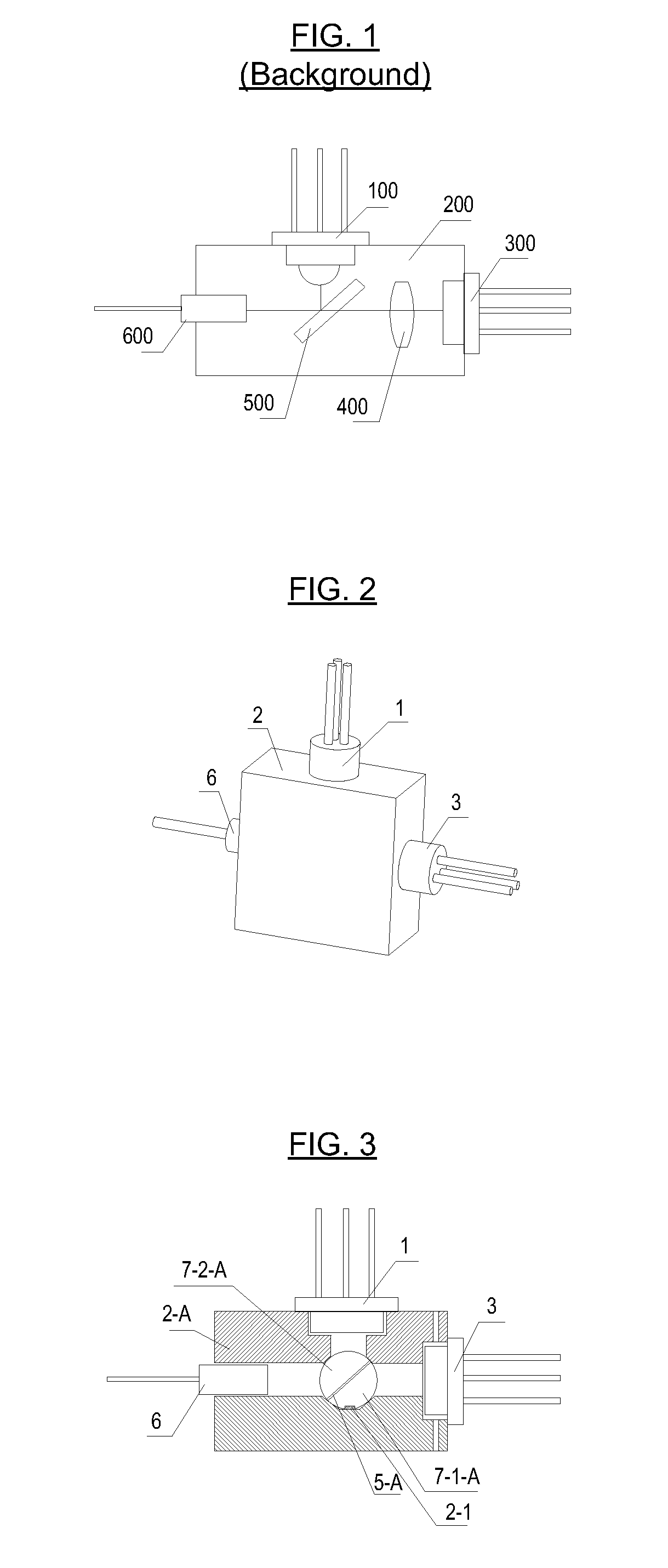Bi-Directional Fiber Optic Transceivers, Housings Therefor, and Methods for Making and Using the Same
a fiber optic transceiver and bi-directional technology, applied in the field of optical transceivers, housings therefor, and methods of making optical transceivers, can solve problems such as serious energy loss, and achieve the effect of small housing outline and high coupling efficiency
- Summary
- Abstract
- Description
- Claims
- Application Information
AI Technical Summary
Benefits of technology
Problems solved by technology
Method used
Image
Examples
embodiment i
[0087]FIG. 2 generally shows an exterior view of the bi-directional fiber optic transceiver of the present invention, comprising a photodiode 1, a laser diode 3, a fiber 6 and a housing 2. As FIGS. 2 and 3 show, a first embodiment of the bi-directional fiber optic transceiver of the present invention comprises a first hemispherical lens 7-1-A, a second hemispherical lens 7-2-A, and an optical splitter 5-A at a 45-degree angle with regard to the optical path. First hemispherical lens 7-1-A and second hemispherical lens 7-2-A combine to form a spheroid. Laser diode 3 is placed at the focal point of first hemispherical lens 7-1-A, and the photodiode 1 is placed at the focal point of second hemispherical lens 7-2-A. A locating slot 2-1 is below the first hemispherical lens 7-1-A. Housing 2-A for the optical transceiver (see FIGS. 3 and 12) comprises a laser diode mounting hole 2-2, a photodiode mounting hole 2-4, a fiber mounting hole 2-5 and an internal cavity 9-A corresponding to the ...
embodiment ii
[0089]As FIGS. 2 and 4 show, a second embodiment of the bi-directional fiber optic transceiver of the present invention comprises a first hemispherical lens 7-1-B, a second hemispherical lens 7-2-B, and an optical splitter 5-B that has a 45-degree angle with regard to the optical path. Planar surfaces of the first hemispherical lens 7-1-B and the second hemispherical lens 7-2-B vertically flank the optical splitter 5-B. Ends of the optical splitter 5-B may be adhered to the first hemispherical lens 7-1-B and the second hemispherical lens 7-2-B with an adhesive. The laser diode 3 is placed at the focal point of the first hemispherical lens 7-1-B, and the photodiode 1 is placed at the focal point of second hemispherical lens 7-2-B.
[0090]Housing 2-B of the optical transceiver (FIG. 13) comprises a laser diode mounting hole 2-2, a photodiode mounting hole 2-4 and an internal cavity 9-B corresponding to the optical splitter 5-B and the hemispherical lenses 7-1-B and 7-2-B. Lower walls of...
embodiment iii
[0091]Referring to FIGS. 2, 5 and 16, a third embodiment of the bi-directional fiber optic transceiver of the present invention comprises a first hemispherical lens 7-1-B, a second hemispherical lenses 7-2-B, and an optical splitter 5-B at a 45-degree angle with regard to the optical path. The flat surfaces of first hemispherical lens 7-1-B and the second hemispherical lens 7-2-B vertically flank the optical splitter 5-B. Ends of the optical splitter 5-B are fixed to the first hemispherical lens 7-1-B and the second hemispherical lens 7-2-B via a rectangular framework (see rectangular framework 10 in FIG. 16), wherein the laser diode 3 is placed at the focal point of the first hemispherical lens 7-1-B, and the optical splitter 5-B is placed at the focal point of the second hemispherical lens 7-2-B.
[0092]Housing 2-B of the optical transceiver (FIG. 13) comprises a laser diode mounting hole 2-2, a photodiode mounting hole 2-4, a fiber mounting hole 2-5 and an internal cavity 9-B corre...
PUM
| Property | Measurement | Unit |
|---|---|---|
| angle | aaaaa | aaaaa |
| angles | aaaaa | aaaaa |
| angles | aaaaa | aaaaa |
Abstract
Description
Claims
Application Information
 Login to View More
Login to View More - R&D
- Intellectual Property
- Life Sciences
- Materials
- Tech Scout
- Unparalleled Data Quality
- Higher Quality Content
- 60% Fewer Hallucinations
Browse by: Latest US Patents, China's latest patents, Technical Efficacy Thesaurus, Application Domain, Technology Topic, Popular Technical Reports.
© 2025 PatSnap. All rights reserved.Legal|Privacy policy|Modern Slavery Act Transparency Statement|Sitemap|About US| Contact US: help@patsnap.com



